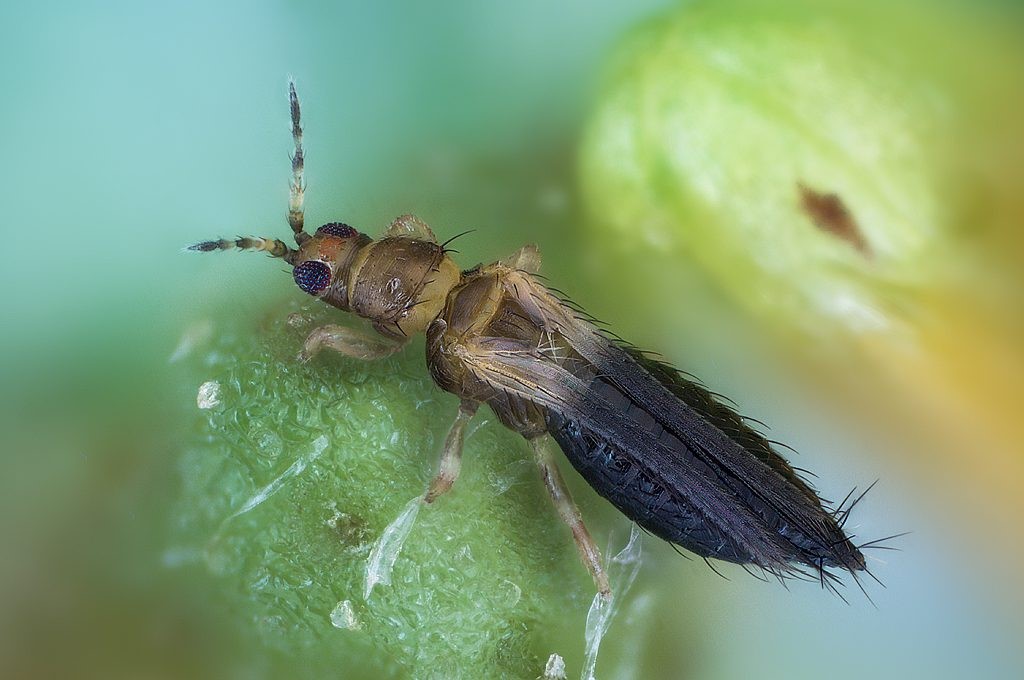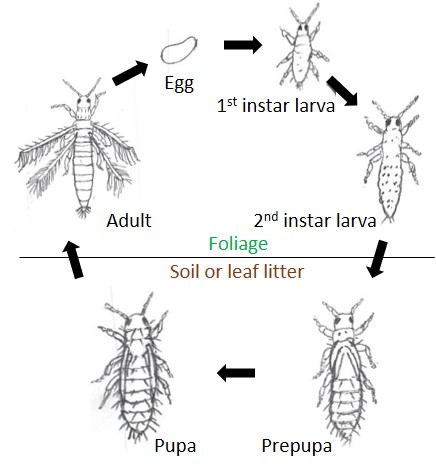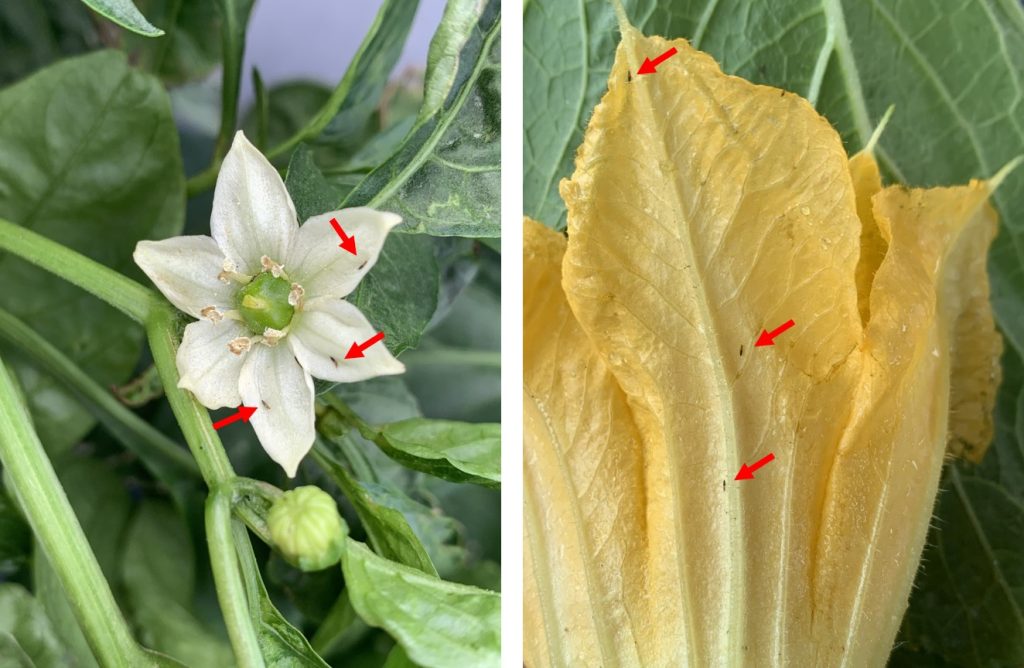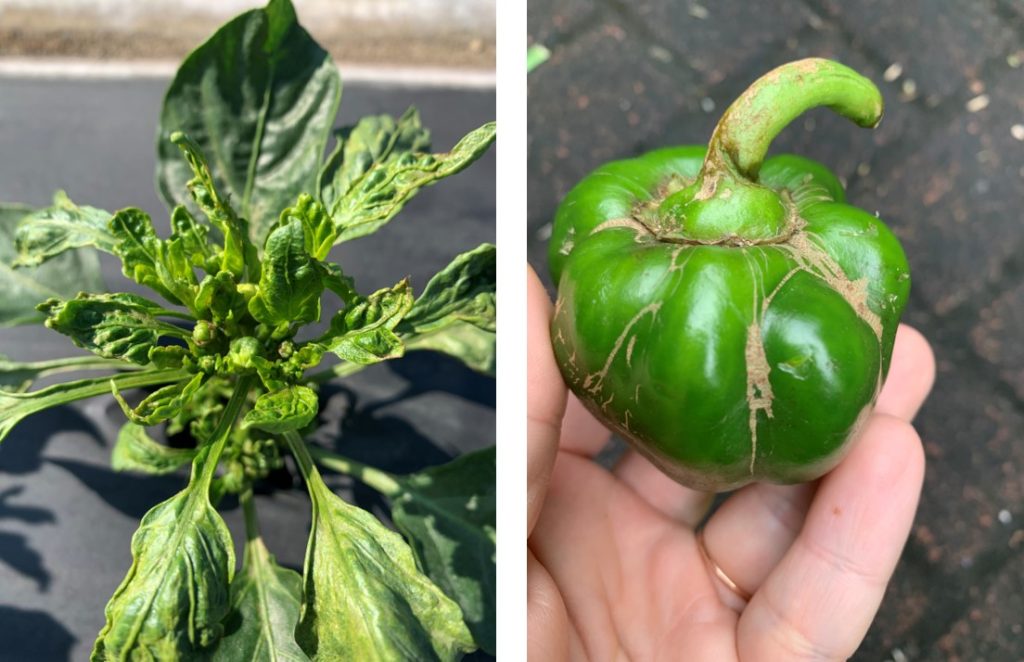Distribution
Thrips parvispinus is an invasive thrips species recently reported in Georgia (Fig. 1). It is widespread in Florida. In 2020, it was first reported and identified in the continental US from Florida. Previously, it was reported from Hawaii. It is native to Asia (such as China, India, Indonesia, Japan, Malaysia, and the Philippines) and is currently reported from 17 countries in Africa, Australia/Oceania, Europe, and North America.

Description

Thrips parvispinusis roughly half the length (~1 mm long) of common thrips (such as chilli thrips or western flower thrips). The body of this thrips is dark-colored. The head and thorax are brown colored and the abdomen is a uniform black color. The wings follow a similar shift in color, with the base (over the thorax) brown and the portion over the abdomen dark (Fig. 2). Wings are elongated and narrow-shaped. The margins of the wings are fringed. They jump and fly using their fringed wings and disperse short distances. The mouth parts of thrips have stylets and a mandible which are used to punch the tissue and suck the cell content.

Biology and Lifecycle
Under greenhouse conditions, this thrips species takes about 14 days from eggs to adults on pepper (Fig. 3). The eggs are inserted into the plant tissue, mainly on bracts by the females. A female lay about 15 eggs. In about 5 days, the eggs hatch, and the larvae go through two larval stages, which take about 5 days. The larvae pupate in the soil and emerge within 3 days. Females live about 9 days, whereas males live for about 6 days. Thrips hide under the cracks and crevices of the plants, such as rolled leaves, etc.

Host plants
As a polyphagous insect pest, it can feed on about 43 plant species from 19 families, which includes different crop types, including ornamental plants, fruits, and vegetables. It is reported as a pest on ornamentals, solanaceous vegetables, and papaya. On ornamentals, they are found on gardenia (Gardenia jasminoides), hibiscus, pinwheel jasmine (Tabernaemontana divaricata), Dapladenia, etc. These plants are sold in box stores in Georgia.
Damage
Both adults and larvae of thrips feed on the leaf and flower tissue (Fig. 4). As more feeding occurs, a light-colored spot appears on the surface, gradually turning brown (Fig. 5). The feeding damage on the leaves and fruit produced silver scars (Fig. 6). They feed on all areas of leaves and fruits. The feeding damage in the early stages of leaf or fruit development later appears distorted or twisted-shaped, resembling viral infection. There are no reports of any viruses transmitted by this thrips species. This damage to ornamental can affect the aesthetic appeal and salability. On agronomic crops, it can reduce crop yield.


Monitoring and Management
Generally, thrips are monitored by beating the plants onto a white paper attached to a clipboard. These thrips are small but will be visible to the naked eye. The biological control strategy in the enclosed structure was successfully implemented against thrips. Minute pirate bugs and predaceous mites are commonly used. In general, the products of active ingredients, such as acephate, spinosad, sulfoxaflor + spinetoram, tolfenpyrad and cyantraniliprole, are effective on thrips. Please carefully read the insecticide product label before making an application because the insecticide label is the law.
References
Ahmed, M.Z., A.M. Revynthi, C.L. McKenzie, and L.S. Osborne. 2023. Thrips parvispinus (Karny), an emerging invasive regulated pest in the United States. [https://mrec.ifas.ufl.edu/lsolab/thrips/thrips-parvispinus/]. [accessed on 28 April 2023].
Hutasoit, R.T., Triwidodo, H., and Anwar, R. 2017. Biology and demographic statistic of Thrips parvispinus Karny (Thysanoptera: Thripidae) in chili pepper (Caspicum annuum Linnaeus). Indonesian Journal of Entomology, 14: 107–116.
Johari, A., Herlinda, S., Pujiastuti, Y., Irsan, C., and Sartiami, D. 2014. Morphological and genetic variation of Thrips parvispinus (Thysanoptera: Thripidae) in chili plantation (Caspicum annuum L) in the lowland and highland of Jambi Province, Indonesia. American Journal of BioScience, 2: 17–21.
Lim, W.H. 1989. Bunchy and malformed top of papaya cv. Eksotika caused by Thrips parvispinus and Clodsporium oxysporum. Mardi Research Journal, 17: 200–207.
Mound, L.A., and Collins, D.W. 2000. A southeast Asian pest species newly recorded from Europe: Thrips parvispinus (Thysanoptera: Thripidae), its confused identity and potential quarantine significance. European Journal of Entomology, 97: 197–200.
Mound, L., Nakahara, S. and Tsuda, D.M. 2016. Thysanoptera-Terebrantia of the Hawaiian Islands: an identification manual. Zookeys, 549: 71–126.
Soto-Adames,F.N. 2020. Thrips parvispinus (Karny). Florida Department of Agriculture and Consumer Services, Division of Plant Industry. FDACS-P-01926.
The Netherlands Plant Protection Organization. 2019. Thrips parvispinus. Quick scan, QS.Ent./2019/001